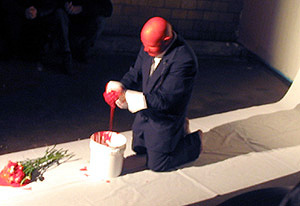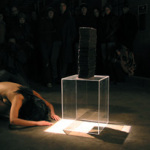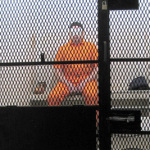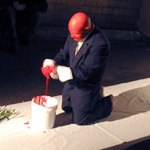Chocolate, whiskey, and the aroma of cake and rotting meat were among the bodies of material that confronted the senses during "Corporeal Heat", a festival of performance art featuring nine artists from Canada, Germany, and the United States. The festival took place in the former district four police station in Boston's South End - a wonderful raw space whose frigid temperature gave a certain significance to the festival's title. The festival was created and curated by students at the School of the Museum of Fine Arts working under Jamie McMurry in the performance area. Performance, generally speaking, involves witnessing and participating in bodily experience. To this end, the performances created at "Corporeal Heat" offered a great deal. The diversity of work, stylistically and with regards to material choices and subject matter, made braving the cold a worthwhile sacrifice.
In "Departures", Marilyn Arsem took us through a progression of metaphors for the body. Throughout the performance, Arsem hung several spherical containers across the space containing a variety of matter denoting the body as substance and material - rotting meat, moist soil, salt water, breath. The piece ponders, in part, the significance of death, one of those uniquely human dilemmas. Explaining, "this is my body and this is my body," as she gestured to the rotting meat, then the soil, Arsem created a relationship between her body as it is and as it will be.
In "Chocolate Piece", Hiroko Kikuchi performed a series of actions using bars of chocolate. I had the pleasure of seeing this piece before. On this occasion, the chill in the air on Kikuchi's exposed body seemed to give the performance a more frantic if somewhat desperate feel. One of the actions entailed Kikuchi attempting to balance on top of a chocolate bar placed on the ground. Her balancing act suggested the balance struck within the performance as a whole, between frenetic behavior and calm deliberate action. The piece insinuates an antagonistic relationship between performer and material, one that Kikuchi has explored in prior works concerning food.
"Nameless" began as a disturbed, self involved activity; John G. Boehme repeating his name over and over, piece by piece. Eventually, he approached an audience member, they introduce themselves and Boehme begins to riff off of her name. He approaches another victim, and another, continually shifting between everyone he has added to his repertoire. For each person, Boehme makes a name tag, giving the piece the atmosphere of a lunatic corporate mixer. If you repeat someone's name three times, the advice goes, you won't forget it; but this guy takes it a little too far. Boehme dissects each person's name down to the individual phoneme, riffing off of each like a variation on a theme, and with each variation infecting the exchange with different meanings that cross back and forth between ridicule and ridiculous.
Jeffery Byrd's gorgeous falsetto seemed to come out of nowhere as his performance, "Holy Ghost", began. Soon, a diminutive red-faced man in a suit emerged from the crowd. I suppose the obvious resemblance to the devil should have immediately struck me, but Byrd's friendly (albeit mischievous) demeanor lead me to a different interpretation of his appearance. The piece was imbued with a vaudeville quality through Byrd's vamping and mockery. Thus Byrd's red-face appeared as a twist on the practice of black-face. In a sense, the same circularity of mockery that black-face represents within the history of (racial) humor in the U.S. was at play in Byrd's performance with regards to the culture of fire and brimstone Christianity in the U.S. Manipulated edits of religious standards such as Old Time Religion served to underscore Byrd's actions, stuttering and falling apart over the course of the performance.
System HM2T's (represented at this festival by Helge Meyer) piece "Homage" was by far the least theatrical of the festival's performances, and stood in stark contrast to Byrd's. The piece is about exchange. It is an exchange of clothing and of stories. Audience members who volunteered a piece of clothing, received in exchange, an article of clothing given to Meyer by someone from a previous exchange in the Philippines, Canada, Germany, and elsewhere. Meyer shared a story about each piece of clothing on his body and invited audience members to do the same before swapping these items. Thus, Meyer acts as a conduit for both the stories and clothing.
Julie Andree T and Dominic Gagnon's "Silent Logistics" offered an understated intensity that I really enjoyed. The messiness of both the materials and execution of the series of actions the artists engaged in evolved organically toward its conclusion. There was a give and take to the proceeding, often an exchange of tenderness and suffering that was remarkable to witness. At the end, they washed each other's hair, an action whose affection was underscored by Andree T having just dragged a shirtless Gagnon by the ankles around a circle previously drawn on the floor.
In a sense, Dan McKereghan's performance "Some Truth" was very simple. Dressed in an orange prisoner jumper, wearing eye-patches and a hair net, he remained, motionless, in a prison cell for the 28-hour duration of the festival. Durational performances of this kind have a way, from the audience's perspective, of transforming the performer into an object - an image to contemplate and consume. In this case, the image of McKereghan invoked, for me, that of the enemy combatants held by the U.S. in Guantanomo Bay. For the performer, the duration is felt the whole way, and the piece exists nearly as the antithesis of the image it creates. Taken together, these two perspectives suggest the disjuncture between an experience and its image. I suspect "Some Truth" - whose titled is borrowed from John Lennon's "Gimme Some Truth", exists most strongly in the mind of McKereghan and in recollections of the experience he recounts to others. The strength of the piece, for me, is in not knowing the impact of the piece from the inside.
In addition to those mentioned, Deva Eveland and Nezaket Ekici each performed both nights. Eveland performed a durational piece in a jail cell each night entitled "Observation of a Hitherto Unknown Specimen". Like McKereghan's, Eveland's performance raised questions about the use of language to name the unknown, but unlike McKereghan's, invited interaction from the audience. Ekici performed "Black Sea" on April 2 and "Hullabelly" April 3 both of which used music and simple action to create a vignette composed of cross-cultural elements.
It was a treat to see a strong body of diverse performance work, particularly in a city that has proven unkind to alternative spaces where this work would otherwise be exhibited. That the curators were able to make the festival happen in spite of that challenge only adds to the success of "Corporeal Heat".
- Dan McKereghan performing Some Truth
- Dan McKereghan performing Some Truth
- Jeffery Byrd performing Holy Ghost
Links:
A Corporeal Heat website
"Corporeal Heat" was on view April 2nd & 3rd at the abandoned D-4 police station.
Image of Hiroko Kikuchi is courtesy of Jeremy Liu. All others are courtesy of Dirk Adams.
Dirk Adams is an artist. He also runs the sometimes operational advice service ask! eDirky.






